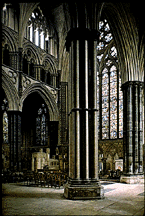

Just what is a cathedral? It is "a church which contains a cathedra or a throne for a bishop" (1). Originally cathedrals were the homes of Benedictine monks and inexpensive and readily available materials were used to build them. Roofs were made of timber, usually oak. Stone was used to construct the walls and could come from a variety of English mines. The most common stone used was limestone.
In Italy, marble was easily obtained and frequently used. Virtually no marble was imported into England, however, during the Gothic period. English master masons used "Purbeck marble" instead. This was not really marble at all, but a black stone with a texture and markings not unlike real marble. Its name came from a large English rock quarry in a town called Purbeck. In the above image of Lincoln cathedral, purbeck marble can be seen. It is the black stone used on the columns.
The master builders and craftsmen of the Gothic era learned through trial and error how to build strong, tall edifices that were both light and decorative. Some of the obstacles facing these men were wind pressure, balance, mass, abutment, thrust and how to support the sheer weight of these massive structures. Little mathematical theory was used in the design, but tracing and sketching instead. Two mathmatical theories were utilized, however, and with great success. These were the 'Golden Cut' in which the ratio of the side to the diagonal of a square (1:1.4142), and of the side to the diagonal of a pentagon (1:1.618) were calculated. Also used was Fibonnacci's system of whole numbers (5, 8, 13...).
(1) p. 19, John Harvey, "Cathedrals of England and Wales" (see bibliography section)


